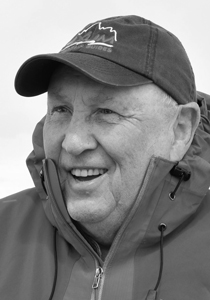Citation
Bob received his bachelor’s degree from Utah State University in 1960 and his Ph.D. from the University of Utah in 1967. Soon thereafter, he joined the University of Utah faculty. He is a talented geophysicist whose scientific work focused on Yellowstone and the tectonics of the Basin and Range. To a remarkable degree, he has made outstanding contributions to each of the areas of the American Geophysical Union (AGU) sections sponsoring the Silver Award.
Bob played an important role in the development of multiple major initiatives over the last 30 years. He helped form the Incorporated Research Institutions for Seismology (IRIS) in 1984. His contributions as an early developer of scientific GPS geodetic networks helped lead to the creation of the University Navstar Consortium (UNAVCO) in its early days in the 1980s, and he helped guide it through its eventual incorporation. He served many years on the Advisory Council for the Southern California Earthquake Center (SCEC), including as its first chair. He was a cofounder of the National Science Foundation (NSF) EarthScope program focused on understanding the structure, evolution, and active tectonics of North America. He was the founding scientist of the Yellowstone Volcano Observatory in 1990 and continues as coordinating scientist.
Bob represents the best in unselfish collaboration in scientific research and in scientific organization and infrastructure development. In addition to the many students he trained in his own group at Utah, his influence extends internationally through collaborations he fostered with younger scientists around the world. He is also known for the exceptional time and energy he devotes to educating the public, civil and emergency response authorities, and politicians on earthquake and volcano hazards. The Paul G. Silver Award recognizes Robert Smith’s outstanding, multifaceted, and sustained record of service to the AGU community.
—Gregory C. Beroza, Stanford University, Stanford, Calif.
Response
It is most rewarding to receive the Silver Award in the name of Paul G. Silver, a long-time scientific collaborator, and I thank the Seismology, Geodesy, and Tectonophysics sections, with whom I have been affiliated for than 45 years. I formulated much of my philosophy when I experienced the 1959 M 7.3 Hebgen Lake, Mont., earthquake that was closely followed when I learned how to fly a jet in the U.S. Air Force in 1963 and in only 1 year learned how to drive a dog team exploring Antarctica as the U.S. exchange scientist to the British Antarctic Survey. My early academic efforts involved, with associates, forming the Program for Array Seismic Studies of the Continental Lithosphere (PASSCAL) consortium for seismic instrumentation that later merged into IRIS. On the basis of my using GPS and leveling work in Yellowstone, colleagues and I formed a geodetic instrument consortium, UNAVCO. Again, associates and I formed a consortium to study the evolution of North America, treating it as a natural geologic laboratory, forming the EarthScope program. Moreover, my interests in understanding earthquake physics through integrating multiple geologic data led me to become a member of SCEC, where integration of methods and tools is practiced so well. And I have always viewed Yellowstone as “a window into Earth processes” that led me along with National Park Service and the U.S. Geological Survey (USGS) scientists to form the Yellowstone Volcano Observatory. Critically, I have always involved and mentored young faculty, successfully supervising 70 graduate students, and tried to set an example of how to organize their own science programs. In closing, I am grateful to the NSF and the USGS for their support and to the University of Utah, which has always supported my academic interests.
—Robert B. Smith, University of Utah, Salt Lake City
Citation: AGU (2015), Smith receives 2015 Paul G. Silver Award for Outstanding Scientific Service, Eos, 96, doi:10.1029/2015EO035951. Published on 28 September 2015.
Text © 2015. The authors. CC BY-NC 3.0
Except where otherwise noted, images are subject to copyright. Any reuse without express permission from the copyright owner is prohibited.

